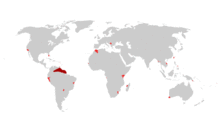Guppies, scientifically known as Poecilia reticulata, are small, colorful freshwater fish that have become popular among aquarium enthusiasts around the world. These lively and beautiful fish are native to certain parts of Central America and the northern part of South America.
Their natural habitat includes countries such as Venezuela, Guyana, Trinidad, and Tobago. Guppies are particularly abundant in the rivers, streams, and pools of these regions. The warm and tropical climate of these areas provides the ideal conditions for guppies to thrive and reproduce.

Credit: en.wikipedia.org

Credit: www.researchgate.net
Geographical Distribution
Guppies are native to a wide range of habitats within their native countries. In Venezuela, they can be found in the Orinoco River basin, while in Guyana, they inhabit the Essequibo and Demerara River basins. In Trinidad and Tobago, guppies can be found in various rivers and streams throughout the islands.
The geographical distribution of guppies extends beyond their native range, as they have been introduced to many other parts of the world. Due to their hardiness, adaptability, and vibrant colors, guppies have become popular aquarium fish and have been introduced to numerous countries for ornamental purposes.
Introduction to Other Regions
Guppies have been introduced to various regions worldwide, including North America, Europe, Asia, and Africa. These introductions have mainly been a result of the aquarium trade, where guppies are prized for their beauty and ease of care.
In North America, guppies have been introduced to several states, including Florida, Texas, and California. They have also been established in some parts of Hawaii. In Europe, guppies can be found in countries such as Spain, Italy, and France. They have also been introduced to parts of Asia, including India, Thailand, and Singapore.
Unfortunately, the introduction of guppies to non-native regions has had ecological consequences. In some cases, guppies have become invasive and negatively impacted native fish populations. They are known to compete for resources and prey on the eggs and fry of other fish species, which can disrupt the balance of aquatic ecosystems.
Guppies in the Wild
Guppies in the wild exhibit a wide range of colors, patterns, and fin shapes. This variation is due to natural selection and sexual selection processes that have shaped their appearance over time. In their native habitats, guppies have evolved to blend in with their surroundings, providing them with protection from predators.
Male guppies are particularly known for their vibrant colors and elaborate fin displays. These characteristics play a crucial role in attracting females during courtship. Females, on the other hand, tend to have more subdued colors and are often larger in size compared to males.
Guppies in Aquariums
Guppies have been bred in captivity for generations, resulting in a wide range of color and fin variations. These captive-bred guppies often exhibit more intense and diverse colors compared to their wild counterparts. Aquarium enthusiasts have selectively bred guppies to enhance certain traits, leading to the development of strains with unique patterns and colors.
Keeping guppies in aquariums has become a popular hobby due to their ease of care, adaptability, and their ability to reproduce in captivity. They are generally hardy fish that can tolerate a range of water conditions. However, it is important to provide them with a well-maintained aquarium, suitable water parameters, and a balanced diet to ensure their health and well-being.
Conclusion
Guppies are native to Central America and the northern part of South America, specifically Venezuela, Guyana, Trinidad, and Tobago. They thrive in warm, tropical environments such as rivers, streams, and pools. However, they have been introduced to various regions worldwide, mainly through the aquarium trade, and have become established in many non-native habitats.
While guppies are beloved for their beauty and ease of care, their introduction to non-native regions has had ecological consequences. It is crucial to be mindful of the potential impacts of introducing non-native species and to prevent them from becoming invasive.
Whether in their native habitats or in aquariums, guppies continue to captivate enthusiasts with their vibrant colors and lively nature. They serve as a reminder of the diverse and fascinating world of aquatic life.
